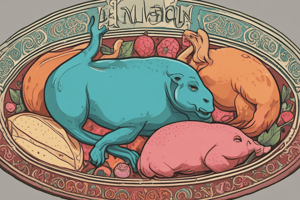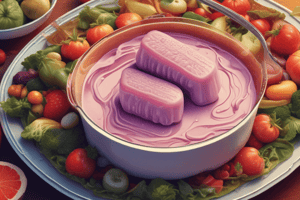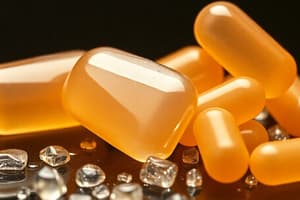Podcast
Questions and Answers
What can denature proteins to form a gel?
What can denature proteins to form a gel?
- Acidic substances, Boiling, Mixing, Steaming
- Light, Oxygen, Time, Freezing
- Heat, pH, Pressure, Shearing (correct)
- Alkaline substances, Microwaving, Fermentation, Drying
Which proteins form thermally irreversible gels?
Which proteins form thermally irreversible gels?
- Muscle proteins (myosin), egg white proteins (ovalbumin) (correct)
- Enzymes, Antibodies
- Plant proteins (gluten), milk proteins (casein)
- Fish proteins (actin), soy proteins (glycinin)
What can prevent the formation of gels?
What can prevent the formation of gels?
- Presence of water, Agitation
- High temperature, Low pH
- Weak attractive forces between proteins (correct)
- Strong attractive forces between proteins
What influences gel properties?
What influences gel properties?
What is the mechanism of thermally induced food gels formation?
What is the mechanism of thermally induced food gels formation?
What is the nature of fructose's substituent groups on the ring and the configuration about the anomeric carbon?
What is the nature of fructose's substituent groups on the ring and the configuration about the anomeric carbon?
In an aqueous solution of fructose at 25 ˚C, what is the composition of the cyclic forms?
In an aqueous solution of fructose at 25 ˚C, what is the composition of the cyclic forms?
What is the difference between the cyclic forms of fructose?
What is the difference between the cyclic forms of fructose?
In polysaccharides, in what form does fructose exclusively exist?
In polysaccharides, in what form does fructose exclusively exist?
What is the defining characteristic of conformational isomers?
What is the defining characteristic of conformational isomers?




